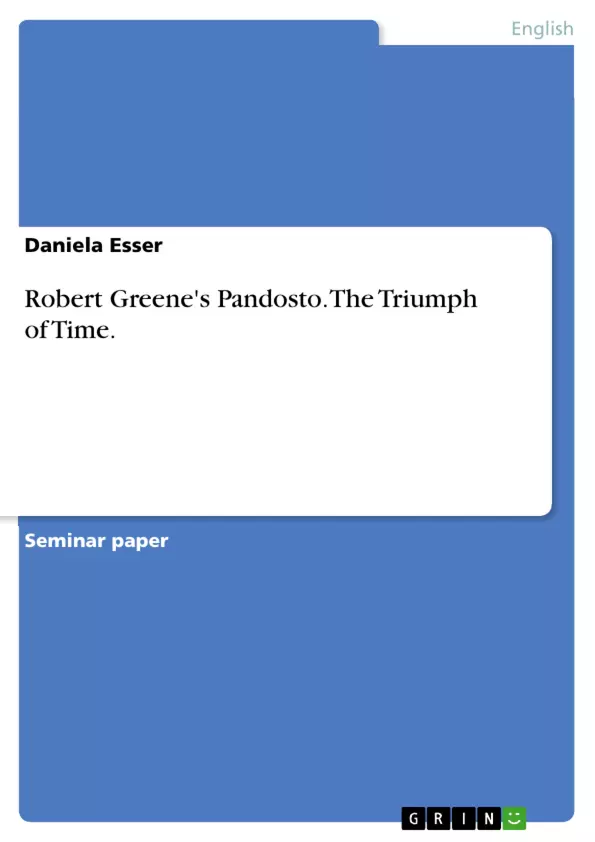Robert Greene was one of the most popular English prose writers of the late 16th century and Shakespeare′s most successful predecessor in blank-verse romantic comedy. He was also one of the first professional writers and among the earliest English autobiographers1. His early prose works show the influence of John Lyly and the Euphuistic style.2
His novella Pandosto. The Triumph of time3 (first extant edition 1588) is a prose pastoral romance based on Greek tradition that provided Shakespeare with the plot of The Winter′s Tale. The running title of the romance, however, is "The History of Dorastus and Fawnia". The happy love story of Dorastus and Fawnia is framed by the tragic story of the jealous Pandosto, king of Bohemia, and his wife Bellaria. Pandosto′s jealousy is based on a misunderstanding and leads to the abandonment of his child Fawnia and to the death of his beloved wife Bellaria. Pandosto′s life is therefore determined by grief, and he cannot even find his daughter. Fawnia, however, is found by a shepherd and is raised by him as if it was his child. As time goes by, the son of Egistus, king of Sicilia, falls in love with the shepherdess Fawnia who turns out to be a lost princess. So this love story ends happily, and as Greene already claims in the title, truth may be concealed yet time brings the truth to light: "Temporis filia veritas" - truth is the daughter of time.4 With this structural arrangement, the second (happy) generation, namely Dorastus and Fawnia, is framed within the story of the first (unhappy) generation.5
With his depiction of two worlds that have fortune as their main agent, Greene proposes a world picture which was opposed to that of the prevailing moral.
[...]
1 Greene′s last work, The repentance of Robert Greene (1592), is totally autobiographical. See Davis, Walter R.: Idea and Act in Elizabethan fiction. Princeton: Princeton University Press, 1969, p. 183.
2 See Salzman, Paul: English Prose Fiction 1558 - 1700. A critical history. New York: Oxford University Press, 1985. p. 59.
3 This paper is based on the edition given in Shakespeare, William: The Winter′s Tale. Ed. J. H. P. Pafford. The Arden Shakespeare. Walton-on-Thames: Thomas Nelson and Sons Ltd.,[...]
4 See An Anthology of Elizabethan Prose Fiction. Ed. Paul Salzman. Oxford: Oxford University Press, 1987, p. 399.
5 See Newcomb, Lori Humphrey: " `Social Things`: The production of popular culture in the reception of Robert Greene′s Pandosto." ELH 4/1994, p. 757.
Table of Contents
- Quotation
- Introduction
- Elizabethan prose fiction and Robert Greene
- Pandosto - an interpretation
- The title
- The story of Pandosto and Bellaria
- The story of Dorastus and Fawnia
- Greene's world picture in Pandosto: Time and Fortune
- Conclusion
Objectives and Key Themes
This essay examines Robert Greene's novella, Pandosto. The Triumph of Time, analyzing its place within the literary landscape of Elizabethan prose fiction. The essay aims to explore the unique blend of pastoral and Greek romance elements in the story, highlighting Greene's distinctive world picture, particularly the interplay of time and fortune.
- The influence of Greek tradition and pastoral romance on Elizabethan prose fiction
- Greene's distinctive style and world picture in Pandosto
- The theme of jealousy and its consequences in the narrative
- The role of time and fortune in shaping the characters' destinies
- The juxtaposition of tragic and happy love stories in the novel
Chapter Summaries
The essay begins with a brief introduction outlining Robert Greene's significance as a prose writer during the Elizabethan period. It highlights his novella Pandosto. The Triumph of Time as a key work that influenced Shakespeare's The Winter's Tale.
Chapter 2 delves into the broader context of Elizabethan prose fiction, examining the rapid social development, increasing literacy, and growing publishing industry that fostered an expanding literary audience. This chapter explores the diverse forms of narrative emerging during this time, particularly the evolving nature of romance.
Chapter 3 provides a detailed interpretation of Pandosto, focusing on its complex narrative structure and thematic elements. This chapter analyzes the title, the stories of Pandosto and Bellaria, and Dorastus and Fawnia, highlighting Greene's unique blend of Greek tradition and pastoral romance. It examines the theme of jealousy, its consequences, and Greene's depiction of time and fortune as influential forces.
Keywords
This essay primarily focuses on the themes of jealousy, time, and fortune within the context of Elizabethan prose fiction. Key terms include pastoral romance, Greek tradition, Robert Greene, Pandosto, The Winter's Tale, literary audience, and the distinctive elements of Greene's world picture.
- Quote paper
- Daniela Esser (Author), 2001, Robert Greene's Pandosto. The Triumph of Time., Munich, GRIN Verlag, https://www.grin.com/document/6570



